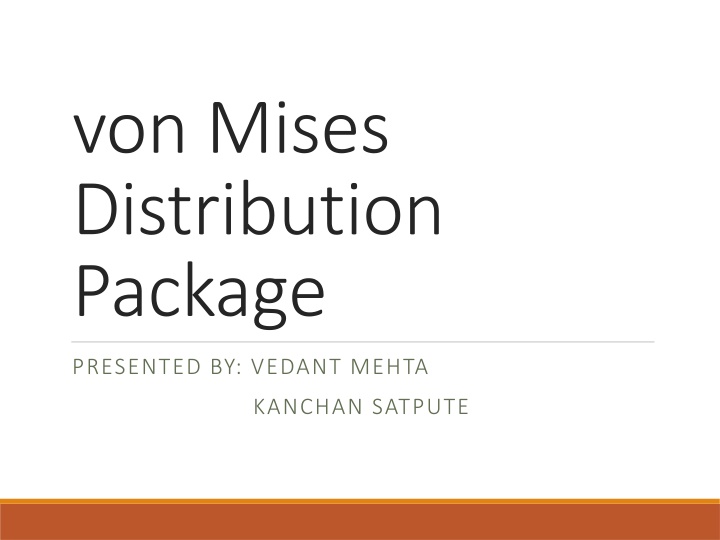
Circular Statistics: Analysis and Techniques for Directional Data
Circular statistics is used when analyzing vector datasets with angles, periodicity, and no true zero. Techniques such as circular histograms, mean calculation, quadrant determination, and variance measurement are essential in understanding and interpreting directional data. The von Mises distribution plays a vital role in circular statistics, similar to the normal distribution in linear statistics, providing a probability density function for measuring location and concentration.
Download Presentation

Please find below an Image/Link to download the presentation.
The content on the website is provided AS IS for your information and personal use only. It may not be sold, licensed, or shared on other websites without obtaining consent from the author. If you encounter any issues during the download, it is possible that the publisher has removed the file from their server.
You are allowed to download the files provided on this website for personal or commercial use, subject to the condition that they are used lawfully. All files are the property of their respective owners.
The content on the website is provided AS IS for your information and personal use only. It may not be sold, licensed, or shared on other websites without obtaining consent from the author.
E N D
Presentation Transcript
von Mises Distribution Package PRESENTED BY: VEDANT MEHTA KANCHAN SATPUTE
Directional (circular) statistics Type of data you use determines the kind of statistics to be used Circular statistics should be used whenever you have a vector dataset A vector dataset that has: Angles Periodicity No true zero
Circular Histogram of wind direction in hourly bins for that month Departure direction of migratory birds
Mean Convert periodic data into an angular measurement: 2? ? ? ? = X value from the data, k scale on which the data has been measured Angular data must be converted to rectangular polar co- ordinates ? ?sin? = ? ? cos? =
Cont. The mean angle can t be calculated using linear mean formula We use the following formula: ? ? ?=1 ?=1 sin ? cos ? ? = ? = ? ? ?2+ ?2 ? =
Cont. Calculate the mean cosine and sine of X and Y obtained from the previous slide ? ? ? ? cos ? = sin ? = So mean angle would be: sin ? cos ? ??= arctan
Cont. Determining the quadrant: Sin +, cos + : mean angle computed directly Sin +, cos - : mean angle = 180 ?? Sin -, cos - : mean angle = 180 + ?? Sin -, cos +: mean angle = 360 ??
Variance Circular variance measures variation in the angles about mean direction It ranges from 0-1 Value of 1 means concentration in one direction Value of 0 means equally dispersed around the circle
von Mises distribution von Mises distribution in circular statistics is analogous to normal distribution in linear statistics Probability density function is given by: 1 ? ? ?,? = 2???(?)exp ?cos(? ?) ? measure of location ? measure of concentration ( 1/? is analogous to ?2 )
PDF & CDF PDF CDF If ? is zero, the distribution is uniform If ? is large, the distribution becomes concentrated about the mean and approaches a normal distribution
von Mises Representation ? = 0 ? = 10
von Mises R support R has a popular package named circular which covers most of the functions for circular statistics (inclusive of von Mises distribution) It also has another package named CircStats which has most of the basic functionalities of circular statistics covered Python doesn t have a very good support for circular statistics and von Mises distribution in specific
von Mises package We have built a package vonMises for Python 3 and is available on PyPi It consists of following functions: rvonmises - Generate random deviates from vonMises distribution dvonmises - Computes probability density on the basis of vonMises probability density function pvonmises - Computes cumulative probability on the basis vonMises cumulative distribution function qvonmises - Generates quantiles i.e., basically the inverse of vonMises cumulative distribution function
Methods rvonmises( n, mu, kappa) dvonmises(x, mu, kappa):- Default parameters: {log = False, class = circular } pvonmises(q, mu, kappa):- Default parameters: {from_ = None, tol = np.exp(-20), log = False} qvonmises(p, mu, kappa):- Defualt parameters: {mu = circular(0), kappa = None, from_ = None, tol = np.finfo(float).eps**0.6} Common default parameters for all the functions: {type ="angles", units= "radians", template= "none", modulo= "asis", zero= 0, rotation= "counter }
Results: R vs Python Method R Python pvonmises(2, 1, 6) pvonmises([2, 0.8], 2, 6) [0.9888944] [0.5 , 0.003595458] [0.988894] [0.5 , 0.00359546] dvonmises(0.5, 1, 6) dvonmises([1, 3], 3, 6) [0.4581463] [0.45814625] [1.949157e-04, 9.54982e-01] [1.949157e-04, 9.54982e-01] qvonmises(0.5, 1, 6) qvonmises([0.2, 0.6], 2, 7) [1] [1] [1.67413597, 2.09767203] [1.67413597, 2.09767203]
Random number generation R (KAPPA = 1) PYTHON (KAPPA = 1)
Cont. R (KAPPA = 6) PYTHON (KAPPA = 6)
Probability density R PYTHON
Cont. R PYTHON
Benchmarking Function R Python rvonmises 1.98 ms 175 ms dvonmises 25 ms 4 ms
Future scope Making the package more robust to different kind of inputs Optimize the code to decrease runtime Include other functions of circular statistics, similar to circular package, under one hood
